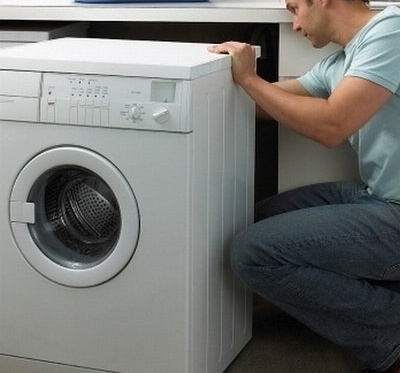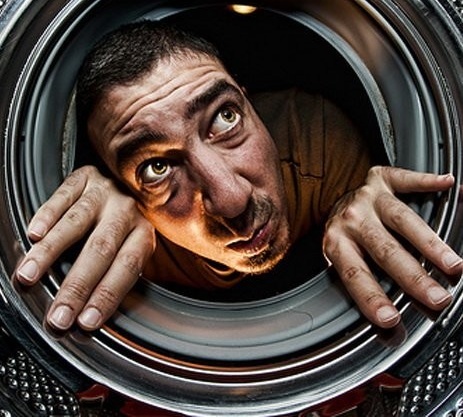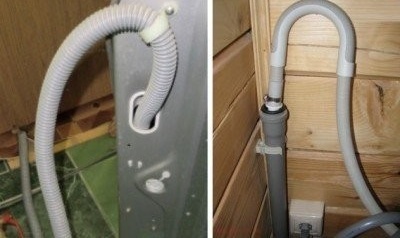Installation of taps for connecting the washing machine to the water supply
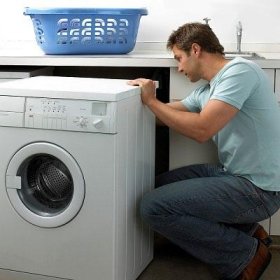
Successfully connecting the washing machine to the plumbing system is one of the most important stages of its installation. Without fail, a special faucet for the washing machine should be installed. This is an important safety measure that will minimize damage in case of a possible breakdown of equipment. Knowing the features of the procedure for connecting the machine to the water supply system is useful if such a tap fails and needs to be replaced, or if a decision has been made to rearrange the machine to a new location. Even a novice plumber can cope with such a task quite satisfactorily if he takes into account a number of important points.
When installing the washing machine, shut-off taps of the simplest design can be used. They should be installed, of course, in such a way that the owner or mistress could at any time close the valve and stop access to the washing machine. Typically, such a faucet remains open during operation of the washing machine, which draws water from the system, heats it, and performs other actions in automatic mode. But in the event of breakdowns, it is often necessary to shut off the water immediately, otherwise it will flood the entire surrounding space and flood the neighbors, if any.
There are two types of shut-off valves that can be used when connecting automatic machines:
- Globe valves that cut into an existing water supply leading to another facility (water heater, mixer, etc.);
- End taps, which are installed on a separate branch of the water supply, designed specifically for the washing machine.
It is best if the water to the washing machine comes through a water pipe of the same cross section as the whole house. It is recommended that you also include a filter in the system so that water enters the machine with additional purification. The filter is a mesh, it is not difficult to install it. At the end of the washing cycle, when the machine turns off, it is recommended to turn off the tap and turn it on only before starting the next wash. In addition, care should be taken to regularly clean the installed filter.
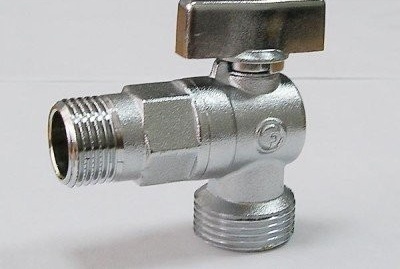
Such an end tap for a washing machine is installed on a separate branch of the water supply, which is designed specifically for these purposes
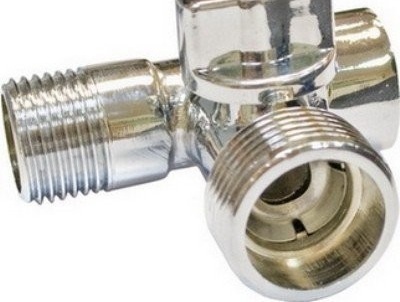
It looks like a stopcock for a washing machine. It makes it possible to supply water to the device from a water pipe to which another device is already connected
If the manufacturer supplies a special hose to connect to the water supply, it should be used. If the length of the hose is not enough, you should not extend it in two parts, since such a hose may soon break. It is better to purchase a longer one-piece hose, while it is recommended to make a purchase in the company store of the manufacturer of the equipment.Cheap analogues of bulk hoses, which are sold in plumbing stores, fail quite quickly.
Content
Hot water connection
There are models of automatic washing machines in which a double connection to the water supply is provided: not only to cold, but also to hot water. Most often this is the technique of Japanese or American brands. This solution allows you to save electricity, which is used to heat the water in the washing machine. However, in practice, in Russian realities, models of this type rarely cope with increased load.
The fact is that this technique is very demanding on the quality of incoming hot water. In central heating systems, water usually does not differ in purity, which leads to fast filter blockages, equipment breakdowns, etc. In addition, the quality of the wash may be completely unsatisfactory. In some cases, rusty stains and other impurities appeared on washed laundry, and cases of damage to delicate fabrics were also observed.
In conditions of individual water supply, water is usually much cleaner. However, in this case, one should nevertheless carefully analyze the water and evaluate its condition before buying a washing machine. It may be necessary to improve the existing cleaning system to prevent the breakdown of expensive household appliances.
Installation of the end crane to the branch
To connect the tap to an existing metal water supply, the mortise clamp, which is a tee, is most often used. It is very simple and easy to use. You will need to purchase a clamp with a guide sleeve and a rectangular rubber gasket, as well as stock up with a metal screwdriver, file and drill. Of course, the water before installing the tee will have to be shut off.
The clamp with the sleeve is carefully and gently screwed to the pipe, while the guide sleeve is pushed out, forming the desired hole. Then the pipe is drilled with a drill and attached to a tee or pipe segment. At its end, an end crane is most often mounted. To do this, you must:
- cut the thread of the appropriate size and type at the end of the pipe;
- wrap the edge with an external thread with a sealant, for example, FUM tape;
- screw the faucet onto the pipe, making noticeable efforts;
- screw the hose that comes with the washing machine to the second end of the tap;
- attach the other end of the hose to the machine;
- check the structure for presence / absence of leaks.
The available process is described in the following video:
If screwing the tap onto the thread with the seal is too easy, you must remove the tap and add a few more turns of the seal, otherwise the tightness of the connection will not be sufficient.
Both ends of the hose for connecting the washing machine to the water supply are equipped with special rubber gaskets that should not be lost. Typically, one end of such a hose is straight and the other is angled. To connect to the water supply, a straight end is usually used, and for the corner end, the hose is attached to the equipment, since it is usually installed almost close to the wall.
How to use a through crane?
In a pipe-to-hose connection, globe valves are very often used. Consider several options for placing this type of structure.
Situation One: there is already a tap in front of the hose with a tap to another object (for example, to the toilet bowl). In this case, the tee crane can be installed both before and after the crane already installed.
Situation Two: the hose to which it is planned to connect the washing machine leads to the water heater.In such a situation, the faucet for the machine should be placed in front of the faucet, which blocks the water for the heater. Otherwise, you will have to block the hot water in the house each time for washing.
Situation Three: a washing machine is installed in the kitchen, next to the sink. Here a through-tap can be installed in front of the mixer. To do this, the mixer is removed, a tap is screwed onto the pipe with cold water instead of a flexible hose, then the mixer is installed again.
When choosing a through-tap, it is necessary to take into account the direction of the flow of water (it is indicated by an arrow on the body), as well as the location and dimensions of the control lever. You should choose a model whose handle when opening or closing the tap will not rest against a wall or other objects.
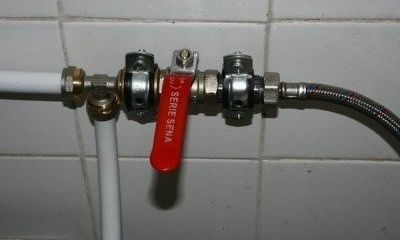
If a faucet with a long handle is selected for connecting the washing machine, make sure that it will be convenient to use the device in both the closed and open positions
The technology for installing a through-tap is as simple as when working with the end structure: a sufficient amount of sealant is wound on the thread, then the valve is screwed, then the seal is wound again and the second end is screwed.
If the master is positioned facing a pipe with an external thread, then wrap the gasket clockwise. At the end of the work, it is necessary to check all the connections for leaks, and before starting work, of course, the water should be shut off (a banal, but not useless reminder).
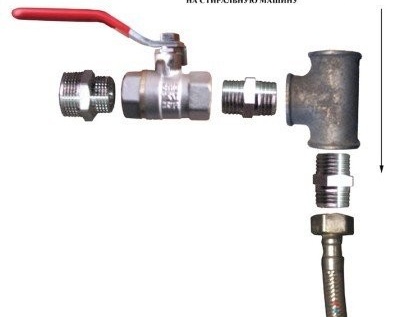
This diagram allows you to understand the procedure for connecting a through-tap for a washing machine. In this case, a tee is used, since the pipe leads to a different point of consumption
Installing a tap before diverting to the toilet bowl, it makes sense if the car is parked in a combined bathroom or toilet. In the latter case, an interesting solution might be to install a small washing machine with horizontal loading not on the floor, but on a special stand.
In this case, the hostess will not have to bend down to load or unload the laundry, it will be more comfortable to use the equipment. You can place the car on a specially mounted shelf, but then you should remember that such a design must withstand a load of about 150 kilograms.
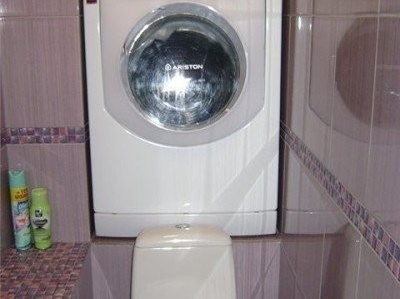
An option to install a washing machine in a recess above the toilet to make it more convenient to use. In this case, it makes sense to connect a check valve to the pipe, which leads to the toilet tank
Mixer tap installation
The attitude of professional plumbers to the idea of installing a through-tap for connecting the washing machine to the water supply to the mixer can be called ambiguous. Such a design does not look very aesthetically pleasing, since the machine’s bulk crane is difficult to place nicely in this situation. In addition, usually the position of the mixer changes, it moves forward, it may not be as convenient to use as it used to be. Finally, there are additional loads for which the mixer was not designed, its service life will be reduced.

Installing a faucet for a washing machine on a mixer is a relatively inexpensive and simple solution, but it creates additional loads on plumbing equipment and is not recommended for continuous use
However, such a solution is quite possible when a temporary connection to the washing machine is necessary. Of course, there is nothing more permanent than temporary solutions, but the owners of the equipment must take into account the risks that arise for their plumbing.
If a faucet is installed in front of an old Soviet-era mixer, which is mounted directly on pipes, it makes sense to put a new mixer. This will facilitate installation and increase the reliability of the entire structure. Otherwise, you will just have to put a mortise clamp on the pipe, which is more expensive and more difficult to install than a regular through-tap.
Sometimes it happens that the ends of the pipes from time to time were damaged by corrosion and became uneven. There are two ways to fix the problem. It will be easiest to file the ends to make them even again. Then the hose gasket can be pressed firmly against the pipe. Another way is to install an extension cord. He will hide the uneven ends, and the hose with the gasket will be fixed on a new, undamaged surface.
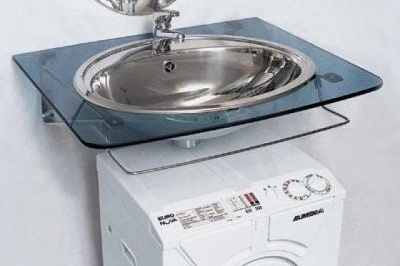
Installing a washing machine under the washbasin can save space in a small bathroom, but connecting the device to the mixer can ruin its appearance
Some craftsmen, in the order of experiment, install a check valve not on the cold water pipe in front of the mixer tap, but after the taps and in front of the nozzle from which warm water flows. This is done so that already heated water enters the washing machine, which allows less energy to be consumed for heating. The solution is nontrivial, but technically not quite right.
When you turn on the crane with such a placement, a mixture will occur, i.e. cold water entering the hot water pipe. As a result, the quality of hot water entering the neighboring apartment may deteriorate. The problem could be resolved by installing check valves in front of the mixer, but then during the washing (i.e. for several hours) it would be impossible to open the taps of the mixer.
If the Aqua-Stop type system is installed on the washing machine (it may be called differently by different manufacturers), then the installation of the crane can be completely abandoned. On such models, the end of the inlet hose is equipped with special solenoid valves that are controlled by the machine and connected to it with special wires. In this case, the control system itself will block the flow of water if necessary, as well as provide unhindered water intake. However, there is no such technique that would not break. if possible, you should still consider installing a crane, even for such machines.
